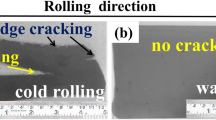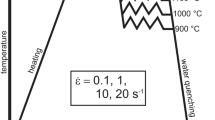Abstract
Reliable assessment of residual stresses in critical structures using x-ray diffraction techniques requires determination of an accurate x-ray elastic constant (XEC) to accurately calculate residual stress state from measured crystallographic elastic strain. Experimental derivation of the XEC is the most reliable approach. This study examines whether experimental XECs derived for quenched and tempered Q1N steel are still accurate to quantify stress in the heat-affected zones (HAZ) of welded joints. A GleebleTM thermal simulator is used to generate coarse-grained, fine-grained and intercritical HAZ microstructure in Q&T Q1N steel. Thermal simulation conditions (grip separation, thermal cycles and cooling rate) were optimized to produce the desired coarse-grained HAZ microstructure at a peak temperature of 1300 °C in large Q1N steel samples. While thermal conditions produced HAZ microstructure and microhardness values that were characteristic of real weld HAZs, there is no measurable effect on bulk elastic properties or the XECs. The bulk elastic modulus has an average value of 204.0 ± 1.3 GPa for the base metal and the selected peak temperatures used for the three different HAZ regions. The XECs have an average value of 176.6 ± 3.6 GPa for the {211} crystallographic planes of bcc Fe for all samples. Results instil confidence in use of base metal XECs for residual stress analysis within actual or real weld HAZ of Q&T Q1N steel on submarine pressure hulls.








Similar content being viewed by others
References
S.P. Farrell, L.W. MacGregor, and J.F. Porter, Stress Analysis on Canadian naval Platforms Using a Portable X-ray Diffractometer, Powder Diffr., 2010, 25(2), p 119–124. https://doi.org/10.1154/1.3425715
C. Rodriguez, J.G. Cabezas, E. Cardenas, F.J. Belzunce, and C. Betegon, Mechanical Properties Characterization of Heat-Affected Zone Using the Small Punch Test, Weld. J., 2009, 88, p 188s–192s
J.A. Gianetto, N.J. Smith, J.T. McGrath, and J.T. Bowker, Effect of Composition and Energy Input on Structure and Properties of High-Strength Weld Metals, Weld. J., 1992, 11, p 407s–419s
J.T. McGrath, J.A. Gianetto, R.F. Orr, and M.W. Letts, Factors Affecting the Notch Toughness Properties of High Strength HY80 Weldments, Can. Met. Q., 1986, 25(4), p 349–356. https://doi.org/10.1179/cmq.1986.25.4.349
C. Aranas, S. Rodrigues, F. Siciliano, and J. Jonas, In-situ X-ray Diffraction Evidence of Dynamic Transformation of Austenite to Ferrite During Hot Compression Test in the Single Austenite Phase Field, Scr. Mater., 2020, 177, p 86–90. https://doi.org/10.1016/j.scriptamat.2019.10.008
Y. Adonyi, Heat-Affected Zone Characterization by Physical Simulations—An Overview on the Use of the Gleeble Discusses the Advantages and Disadvantages of Thermomechanical Simulation, Weld. J., 2006, 85, p 42–47
J.W. Elmer, J. Wong, T. Ressler, T.A. Palmer, Mapping phase transformations in the heat-affected-zone of carbon manganese steel welds using spatially resolved X-ray diffraction. in Trends Weld Res: Proc 6th Inter Conf 35(2): 174–179 (2002). https://doi.org/https://www.osti.gov/servlets/purl/15005690-Mu55xp/native/
Gleeble is the registered trademark of Dynamic Systems Inc., Poestenkill, NY https://doi.org/http://gleeble.com.
J.A. Gianetto, G. Goodall, Gleeble simulation of HAZ regions in Q1N steel. Defence R&D Canada, Atlantic Research Centre, Halifax, Internal report D19, p 23 (2009).
J.P. Balaguer, Z. Wang, and E.F. Nippes, Stress-Relief Cracking of a Copper-Containing HSLA Steel, Weld. J., 1989, 68(4), p 121s–131s
C. Thaulow, A.J. Paauw, and K. Guttormsen, The Heat Affected Zone Toughness of Low Carbon Microalloyed Steels, Weld. J., 1987, 1119, p 266s–279s
Continuous cooling transformation (CCT) phase diagram for HY80 (1999). In: Kasugai T, Fujita M, (eds) Atlas of CCT diagrams for welding (I). National Research Institute for Metals, NRIM-special report No. 99-02, Ibaraki Japan, p 284
J. Lu, Comparative study of different techniques, Handbook of Measurement of Residual Stresses, J. Lu, Ed., The Fairmont Press Inc, Lilburn, 1996, p 225–231
W. Jiang, W. Chen, W. Woo, S.-T. Tu, X.-C. Zhang, and V. Em, Effects of Low-temperature Transformation and Transformation-Induced Plasticity on Weld Residual Stresses: Numerical Study and Neutron Diffraction Measurement, Mater. Des., 2018, 147(5), p 65–79. https://doi.org/10.1016/j.matdes.2018.03.032
A.S.M.Y. Munsi, A.J. Waddell, and C.A. Walker, A Method for Determining X-ray Elastic Constants for the Measurement of Residual Stress, Strain, 2003, 39(1), p 3–10. https://doi.org/10.1046/J.1475-1305.2003.00044.x
P.J. Withers and H.K.D.H. Bhadeshia, Overview: Residual Stress part 1—Measurement Techniques, Mater. Sci. Technol., 2001, 17, p 355–365. https://doi.org/10.1179/026708301101509980
B.D. Cullity, Elements of X-ray Diffraction, 2nd ed., Addison Wesley Publishing Co., Inc., Massachusetts, 1978, p 555
M.E. Fitzpatrick, A.T. Fry, P. Holdway, F.A. Kandil, J. Shackleton, L. Suominen (2005) Measurement good practice guide No. 52: determination of residual stresses by X-ray diffraction—Issue 2. National Physical Laboratory, United Kingdom; internal report, p. 68. https://doi.org/http://oro.open.ac.uk/id/eprint/11283.
M.E. Brauss, G.V. Gorveatte, and J.F. Porter, Development of a Miniature X-ray Diffraction Based Stress Analysis System Suitable for Use on Marine Structures, Proc. SPIE NDE Mater. Compos., 1996, 2944, p 307–317. https://doi.org/10.1117/12.259071
P.S. Prevéy, X-ray diffraction residual stress techniques, ASM Handbook 10: Materials Characterization, R.E. Whan, Ed., American Society for Metals, Ohio, 1986, p 380–392
ASTM E 975-13 (2013) Standard practice for X-ray determination of retained austenite in steel with near random crystallographic orientation”. Annual Book of ASTM Standards, ASTM International, Philadelphia: 03.01, pp. 916–721.
I.C. Noyan and J.B. Cohen, Residual stress—measurement by diffraction and interpretation, Springer Series on Materials Research and Engineering, B. Ilschner and N.J. Grant, Ed., Springer, New York, 1989, https://doi.org/10.1002/crat.2170240228
R.H. Marion, J.B. Cohen, The need for experimentally determined X-ray elastic constants. Dept of Materials Sci. & and Eng. Northwestern University, Evanston Ill; Technical report; p 13 (1976).
S.P. Farrell, K.A. Avery, and L.W. MacGregor, Determination of X-ray Elastic Constants for Q1N Submarine Pressure Hull Steel, App. Mech. Mater., 2011, 70, p 285–290. https://doi.org/10.4028/www.scientific.net/AMM.70.285
S.P. Farrell, L.W. MacGregor, Residual stress analysis of Q1N submarine pressure hull steel with the portable miniature X-ray diffractometer. Defence R&D Canada, Atlantic Research Centre, Halifax, Internal report TM 2007–335, p. 71 (2008).
SAE J784a, Residual stress measurement by X -ray diffraction. Report of the Society of Automotive Engineers, New York: p. 119 (1971).
M. Lundberg, J. Saarimäki, J.J. Moverare, and R.L. Peng, Effective X-ray Elastic Constant of Cast Iron, J. Mater. Sci., 2018, 53, p 2766–2773. https://doi.org/10.1007/s10853-017-1657-6
A. Bahadur, B.R. Kumar, and S.G. Chowdhury, Effect of Thermomechanical Treatment on X-ray Elastic Constants and Residual Stresses in HSLA-100 Steel, J. Nondestruct. Eval., 2003, 22, p 53–62. https://doi.org/10.1023/A:1026388426626
A.L. Esquivel, X-ray Diffraction Study of the Effect of Uniaxial Plastic Deformation on Residual Stress Measurements, Adv. X-Ray Anal., 1969, 12, p 269–300. https://doi.org/10.1154/S0376030800005802
R.K. Dutta, R.M. Huizenga, M. Amirthalingam, A. King, H. Gao, M.J.M. Hermans, and I.M. Richardson, In Situ Synchrotron Diffraction Studies on the Temperature-Dependent Plane-Specific Elastic Constants in a High-strength Quenched and Tempered Structural Steel, Scr. Mater., 2013, 69, p 187–190. https://doi.org/10.1016/j.scriptamat.2013.03.031
P.J. Rudnik, A.D. Krawitz, D.G. Reichel, and J.B. Cohen, A Comparison of Diffraction Elastic Constants of Steel Measured with X-Rays and Neutrons, Adv. X-Ray Anal., 1987, 31, p 245–253. https://doi.org/10.1154/S0376030800022047
DEFSTAN 02-736, Requirements for Q1 (Navy) quality steel: part 1 plates”. in Ministry of Defence Standardization, United Kingdom, p. 44 (2004).
C. Bayley, T. Romans, Comparison of pressure hull straightening approaches: mechanical and flame straightening”. Defence R&D Canada, Atlantic Research Centre, Halifax, Internal report TM 2007-184, p. 36 (2008).
W. Steven and A.G. Haynes, The Temperature of Formation of Martensite and Bainite in Low-alloy Steels, JISI, 1956, 183, p 349–359
J.E. Holthaus, M.G. Koul, and A.L. Moran, Property and Microstructure Evaluation as a Function of Processing Parameters: Large hy-80 Steel Casting for a US Navy Submarine, Eng. Fail. Anal., 2006, 13(1), p 1397–1409. https://doi.org/10.1016/j.engfailanal.2005.10.004
J.A. Gianetto, J.E.M. Braid, J.T. Bowker, and W.R. Tyson, Heat-Affected Zone Toughness of a TMCP Steel Designed for Low-Temperature Applications, Trans. ASME, 1997, 119, p 134–144
ASTM E1426-14 Standard test method for determining the effective elastic constants for use in the measurement of residual stress using X-ray diffraction techniques. Annual Book of ASTM Standards, ASTM International, Philadelphia: 2019: 03.01; pp. 916–919 (2019).
M. Belassel, Residual stress analyzer: Theory of operation manual”. Proto Manufacturing Ltd, Windsor, Canada, Internal report (2001).
ASTM E915-10, Standard test method for verifying the alignment of X-ray diffraction instrumentation for residual stress measurement. Annual Book of ASTM Standards, ASTM International, Philadelphia: 03.01, pp. 809–812 (2010).
J.A. Pineault, M. Belassel, and M.E. Brauss, X-ray diffraction residual stress measurement in failure analysis, ASM Handbook 11: Failure Analysis and Prevention, W.T. Becker and R.J. Shipley, Ed., American Society for Metals, Ohio, 2002, p 484–497
K. Masubuchi, F.B. Simmons, and R.E. Monroe, Analysis of Thermal Stresses and Metal Movement During Welding, Weld. J., 1960, 39(12), p 525s–537s
K. Masubuchi, The magnitude and distribution of residual stresses in weldments, Analysis of Welded Structures, International Series on Materials Science and Technology, D.W. Hopkins, Ed., Pergamon Press, Oxford, 1980, p 189–335
Y.J. Heeshen, T. Nitschke-Pagel, and H. Wohlfahrt, New results on the formation of residual stresses due to phase transformations in the welded structural steels St 52-3 and StE 690, Residual Stresses in Science and Technology, E. Macherauchi and V. Hauk, Ed., DGM Informationsgesellschaft, Oberursel, 1986, p 1005–1013
S.G. Dani, The effect of preheat on the structure and properties of the HAZ of a welded quenched and tempered steel plate. University of Wollongong Thesis Collections, p. 159 (1993). https://doi.org/http://ro.uow.edu.au/theses/2500.
P. Yayla, E. Kaluc, and K. Ural, Effects of Welding Processes on the Mechanical Properties of HY 80 Steel Weldments, Mater. Des., 2007, 28(6), p 1898–1906. https://doi.org/10.1016/j.matdes.2006.03.028
L. Grünitz, Evaluation of the welding residual stress state in a thick HY-80 steel plate. in Proc13th International Offshore and Polar Engineering Conference 2003, pp. 141–146 (2003).
P. Deb, K.D. Challenger, and D.R. Clark, Transmission Electron Microscopy Characterizations of Preheated and Non-preheated Shielded Metal Arc Weldments of HY-80 STEEL, Mat. Sci. Eng., 1986, 77, p 155–167. https://doi.org/10.1016/0025-5416(86)90364-2
Acknowledgments
The authors would like to thank internal and external reviewers for their thoughtful and insightful comments and efforts toward improving our manuscript; Mr. Goodall, a PhD candidate at CanmetMATERIALS (formerly CANMET Materials Technology Laboratory), for conducting the GleebleTM thermal simulation and post test analysis; and Mr. Avery and Mrs. Hervé of DRDC Atlantic Research Centre for optical microscopy, microhardness testing and measurement of elastic properties. This research was funded by the Canadian Federal Government Department of National Defence and the Department of Natural Resources Canada.
Author information
Authors and Affiliations
Corresponding author
Additional information
Publisher's Note
Springer Nature remains neutral with regard to jurisdictional claims in published maps and institutional affiliations.
In a previous version of this article the copyright line read “ASM International”. This has now been updated to read “Her Majesty the Queen in Right of Canada, Department of National Defence”.
Rights and permissions
About this article
Cite this article
Farrell, S.P., Gianetto, J.A. Evaluation of Microstructure, Microhardness, and X-Ray Elastic Constants for Simulated Heat-Affected Zones in Q1N Steel. J. of Materi Eng and Perform 30, 396–408 (2021). https://doi.org/10.1007/s11665-020-05243-5
Received:
Revised:
Accepted:
Published:
Issue Date:
DOI: https://doi.org/10.1007/s11665-020-05243-5




